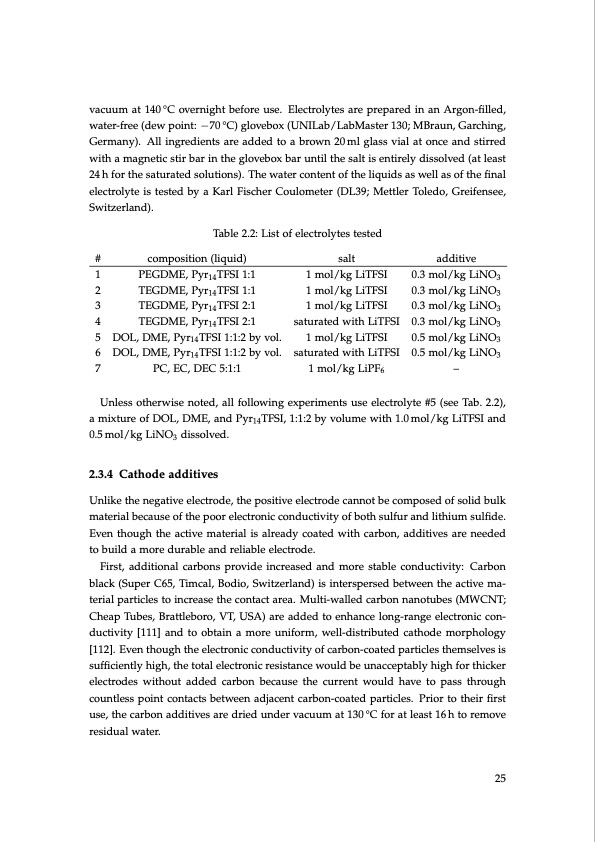
PDF Publication Title:
Text from PDF Page: 025
vacuum at 140 °C overnight before use. Electrolytes are prepared in an Argon-filled, water-free (dew point: −70 °C) glovebox (UNILab/LabMaster 130; MBraun, Garching, Germany). All ingredients are added to a brown 20 ml glass vial at once and stirred with a magnetic stir bar in the glovebox bar until the salt is entirely dissolved (at least 24 h for the saturated solutions). The water content of the liquids as well as of the final electrolyte is tested by a Karl Fischer Coulometer (DL39; Mettler Toledo, Greifensee, Switzerland). # 1 2 3 4 5 6 7 composition (liquid) PEGDME, Pyr14TFSI 1:1 TEGDME, Pyr14TFSI 1:1 TEGDME, Pyr14TFSI 2:1 TEGDME, Pyr14 TFSI 2:1 DOL, DME, Pyr14TFSI 1:1:2 by vol. DOL, DME, Pyr14TFSI 1:1:2 by vol. PC, EC, DEC 5:1:1 salt 1 mol/kg LiTFSI 1 mol/kg LiTFSI 1 mol/kg LiTFSI saturated with LiTFSI 1 mol/kg LiTFSI saturated with LiTFSI 1 mol/kg LiPF6 additive 0.3 mol/kg LiNO3 0.3 mol/kg LiNO3 0.3 mol/kg LiNO3 0.3 mol/kg LiNO3 0.5 mol/kg LiNO3 0.5 mol/kg LiNO3 – Table 2.2: List of electrolytes tested Unless otherwise noted, all following experiments use electrolyte #5 (see Tab. 2.2), a mixture of DOL, DME, and Pyr14TFSI, 1:1:2 by volume with 1.0 mol/kg LiTFSI and 0.5 mol/kg LiNO3 dissolved. 2.3.4 Cathode additives Unlike the negative electrode, the positive electrode cannot be composed of solid bulk material because of the poor electronic conductivity of both sulfur and lithium sulfide. Even though the active material is already coated with carbon, additives are needed to build a more durable and reliable electrode. First, additional carbons provide increased and more stable conductivity: Carbon black (Super C65, Timcal, Bodio, Switzerland) is interspersed between the active ma- terial particles to increase the contact area. Multi-walled carbon nanotubes (MWCNT; Cheap Tubes, Brattleboro, VT, USA) are added to enhance long-range electronic con- ductivity [111] and to obtain a more uniform, well-distributed cathode morphology [112]. Even though the electronic conductivity of carbon-coated particles themselves is sufficiently high, the total electronic resistance would be unacceptably high for thicker electrodes without added carbon because the current would have to pass through countless point contacts between adjacent carbon-coated particles. Prior to their first use, the carbon additives are dried under vacuum at 130 °C for at least 16 h to remove residual water. 25PDF Image | Lithium-Sulfur Battery: Design, Characterization, and Physically-based Modeling

PDF Search Title:
Lithium-Sulfur Battery: Design, Characterization, and Physically-based ModelingOriginal File Name Searched:
Dissertation_David_N._Fronczek_The_Lithium_Sulfur_Battery.pdfDIY PDF Search: Google It | Yahoo | Bing
Sulfur Deposition on Carbon Nanofibers using Supercritical CO2 Sulfur Deposition on Carbon Nanofibers using Supercritical CO2. Gamma sulfur also known as mother of pearl sulfur and nacreous sulfur... More Info
CO2 Organic Rankine Cycle Experimenter Platform The supercritical CO2 phase change system is both a heat pump and organic rankine cycle which can be used for those purposes and as a supercritical extractor for advanced subcritical and supercritical extraction technology. Uses include producing nanoparticles, precious metal CO2 extraction, lithium battery recycling, and other applications... More Info
| CONTACT TEL: 608-238-6001 Email: greg@infinityturbine.com | RSS | AMP |